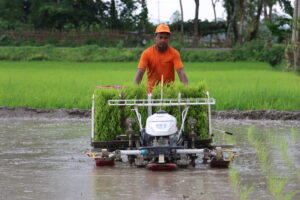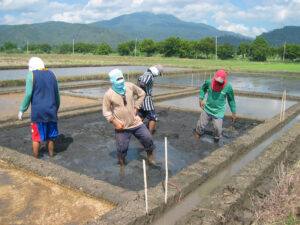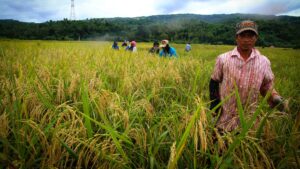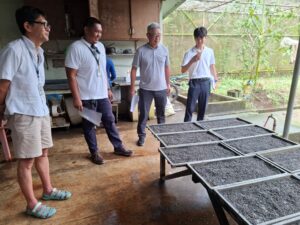By Sharif Ahmed, Abdullah Miajy, Manik Debnath, and Humnath Bhandari

Did you know that most agricultural soils in Bangladesh are low in organic matter, with levels less than 1–2%? This is below the ideal range of 3–5% required for soil fertility. The main reasons for low soil fertility in Bangladeshi soils include continuous cropping without adequate nutrient replenishment, overuse of chemical fertilizers, less crop diversification, complete crop residue removal practices, and inadequate organic matter additions.
Soil fertility is the cornerstone of productive agriculture, yet modern farming practices increasingly threaten its health. Agriculture is the backbone of the Bangladesh economy, and sustainable crop production largely depends on soil health conditions. Organic matter is considered the life of soil because it serves as a reservoir of microorganisms and source of nutrients such as nitrogen, phosphorus, sulfur, and micronutrients. The beneficiary microorganisms of soil, which can help decompose plant foods from inorganic and organic sources, can’t survive in soil without organic matter. Moreover, organic matter acts as a binding agent, promoting the formation of stable soil aggregates and improving porosity, aeration, and root penetration. It also increases the soil’s cation exchange capacity, helping nutrients remain available rather than leach away. In addition to soil fertility and physical improvement, organic matter helps in the sequestration of carbon in soil to mitigate greenhouse gas emissions.
Because of the low organic matter in Bangladeshi soil, farmers often use excessive chemical fertilizers in their fields. This results in a significant amount of chemical fertilizers being applied in crop production, most of which are imported. According to the Ministry of Agriculture in Bangladesh, the annual demand for chemical fertilizers in the country for the most recent fiscal year is approximately 5.95 million tons. This includes 2.70 million tons of Urea, 1.60 million tons of Diammonium Phosphate (DAP), 0.75 million tons of Triple Super Phosphate (TSP), and 0.90 million tons of Muriate of Potash (MOP). Around 80% of the country’s fertilizer needs are met through imports, with limited domestic production amounting to around 1 million tons of urea and only 100,000 tons each of TSP and DAP. The government of Bangladesh typically allocates a significant portion of the national subsidy budget—approximately US$ 2500-3000 million to keep fertilizers affordable for agricultural crop production in the country.
Bangladesh currently provides substantial subsidies on chemical fertilizers to support farmers and ensure food security. However, these subsidies are expected to be gradually reduced in the future, which could significantly impact farmers by increasing input costs and potentially decreasing fertilizer use. The imminent removal of fertilizer subsidies could drive up prices, challenge smallholders’ livelihoods and productivity, and lead to lower crop yields, thereby hampering overall agricultural productivity.
To address these challenges sustainably, promoting nature-based solutions like green manuring becomes essential. Green manuring involves growing cover crops to enrich soil fertility naturally, reducing dependence on chemical inputs, and protecting the environment. Such eco-friendly practices can help farmers adapt to subsidy reductions while ensuring sustainable and productive agriculture.
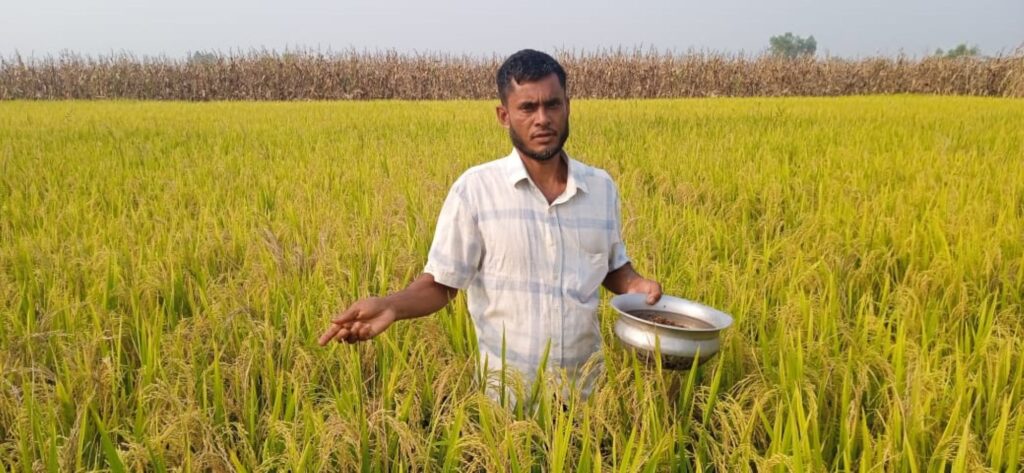
Green manuring as a nature-based, sustainable soil management solution
Green manuring is an agricultural practice in which specific plants, particularly those that fix nitrogen (known as green manure crops), are cultivated and then incorporated into the soil in green conditions to enhance its fertility. This method offers a natural and cost-effective way to improve soil quality without the negative impacts often associated with chemical fertilizers. Green manuring significantly enhances soil fertility through several key mechanisms:
Organic matter increase: Incorporating green manure crops into the soil adds essential organic material, which increases soil organic carbon. This enhancement leads to improved physical properties of the soil, such as better water retention, aeration, and increased porosity—all crucial for healthy root development.
Nutrient enrichment: Many green manure plants, particularly legumes such as Sesbania (Dhancha) and Sunn hemp, possess the ability to fix atmospheric nitrogen through a symbiotic relationship with bacteria. This natural process enriches the soil with bioavailable nitrogen, thereby reducing the need for chemical fertilizers.
Microbial activity enhancement: The organic matter from green manure provides food for soil microbes, enhancing microbial diversity and activity. Healthy microbial populations are vital for nutrient cycling, organic matter decomposition, and the suppression of soil-borne pests and diseases.
Soil chemical properties improvement: Using green manure helps to balance soil pH and enhance cation exchange capacity (CEC), which improves nutrient retention and availability for crops.
Soil erosion and compaction reduction: Covering soil with green manure crops prevents erosion, protects against runoff, and enhances soil structure, allowing roots to penetrate deeply and access nutrients more effectively.
Pest suppression: Green manuring helps suppress pests by covering the soil, which reduces sunlight and space available for weeds to grow. Additionally, it releases natural organic compounds that inhibit weed germination and the proliferation of pests. Moreover, when used in crop rotation, green manuring can break pest and disease cycles.
Long-term benefits: Regular use of green manure crops maintains or even improves soil fertility over time, breaking reliance on chemical fertilizers and promoting a resilient soil ecosystem. Research shows that incorporating fresh biomass of 10 tons per hectare of green manures into the soil provides nitrogen at 75-120 kg per hectare, phosphorus (P2O5) at 5-10 kg per hectare, potassium (K2O) at 20-30 kg per hectare, sulfur (S) at 3-6 kg per hectare, and decomposed organic matter at 5-7 tons per hectare.
IRRI Bangladesh pilot activities on green manuring
Dhaincha (Sesbania) is a popular leguminous green-manuring crop known for its rapid growth, high nitrogen fixation, and substantial biomass production. In 2025, as a pilot initiative from the CGIAR Sustainable Farming program, IRRI Bangladesh introduced Dhaincha seeds for 300 farmers in both northern and southern Bangladesh. Dhaincha was cultivated during the transition period between two crops—after boro rice in the north and after rabi crops in the south. Farmers incorporated the green plants of Dhaincha into the soil within 45 days of sowing and reported producing approximately 15 to 30 tons of fresh biomass per hectare. Immediately after this incorporation, farmers proceeded with aman rice transplanting.
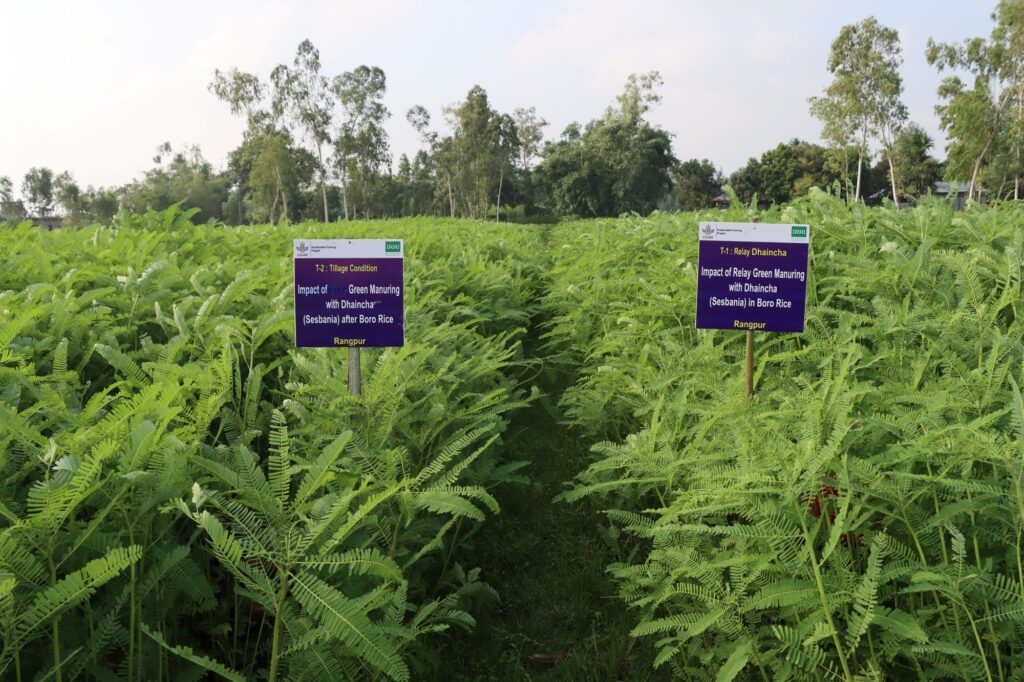
Mr. Mizanur Rahman, a first-time grower of green manuring crops in Iswarpur village, Rangpur District, shared that most of the land in this village remains fallow for 50 to 60 days after the harvesting of Boro rice, until the transplanting of Aman rice. Traditionally, farmers do not grow any crops during this transition period. However, this year, with technical support from IRRI, 12 farmers in our village cultivated green manuring crops after the Boro harvesting. We observed excellent growth of Dhaincha without using any chemical fertilizers or pesticides. We incorporated the crops into the soil using a 4-wheel tractor when they were around 40 days old, at least two weeks before the Aman rice transplanting. We are hopeful that this year we will achieve a higher yield from the upcoming Aman rice. Other farmers in the area are also very interested in growing Dhaincha as green manure in the next season.
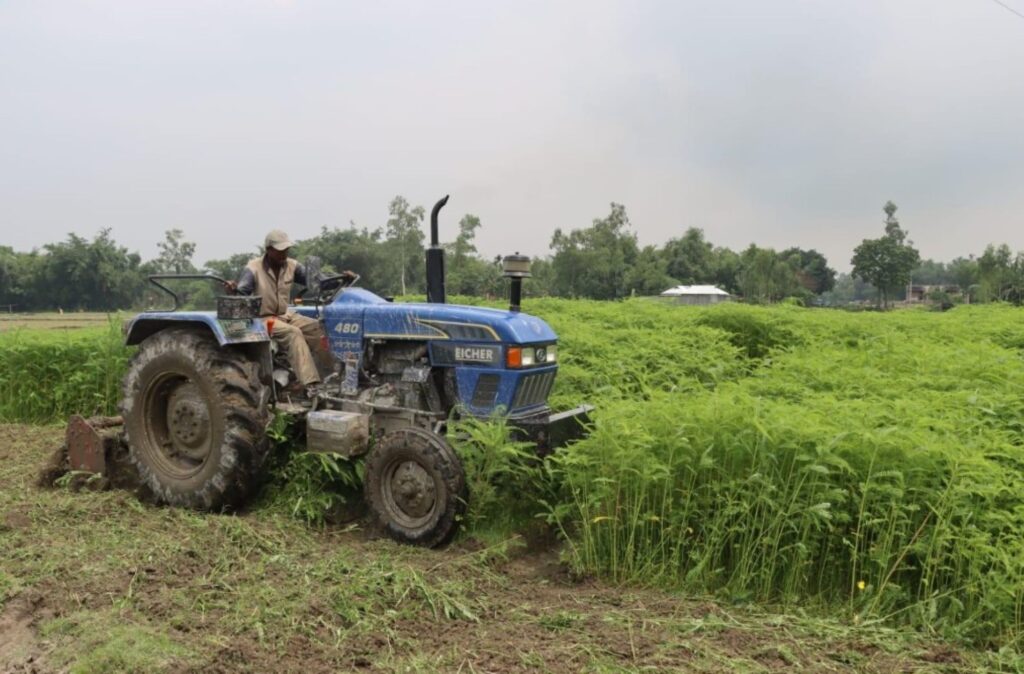
Scaling Approaches of Green Manuring Crops in Bangladesh
Green manure has significant potential to reduce the use of chemical fertilizers, which can lead to substantial cost savings. If it is possible to grow green manuring crops on at least 10% of agricultural land once a year, it could result in a reduction of at least 10% in chemical fertilizer use, translating to approximately US$80-100 million in savings each year. Here are some potential strategies for scaling green manuring crops in Bangladesh.
- In the rice-rice cropping pattern in the northern region, farmers can grow green manuring crops shortly after harvesting boro rice, or they can relay these crops with boro rice.
- In the rice-rabi-rice cropping pattern in the north, farmers can relay dhancha with short-duration boro rice.
- In the rice-fallow pattern in the south, farmers can plant dhancha after the harvest of aman rice.
- In the rice-rabi pattern in the south, farmers can plant dhancha immediately after harvesting rabi crops.
- Seed is a major constraint in its production; however, farmers can tackle this issue collaboratively. One or more farmers in the community can produce seeds and distribute them to others at a low cost. Also, local seed producers may be developed and linked with farmers’ groups through DAE.
- The government, through the Department of Agricultural Extension, can provide a large number of seeds free of charge to farmers. They could encourage farmers to promote integrated nutrient management by applying green manure with chemical fertilizers.
- Organize practical training sessions on green manuring crop cultivation, incorporation techniques, seed production, and storing techniques.
- Organize field days to showcase the benefits of green manuring and facilitate knowledge sharing among farmers.
- Develop user-friendly behaviour change communication (BCC) materials like leaflets, posters, and videos to disseminate information on green manuring practices.
- Social media can be used for scaling of green manuring among the large farmers’ group, though sharing best practices with its real benefit, and also expert consultation about it.
- Integrate with national policies, like including green manuring in Bangladesh’s Sustainable Agriculture and climate-smart initiatives.
- NARES institutes and other agriculturally-focused international organizations may work together for the expansion of green manuring as a climate-smart technology.
Green manuring is a powerful nature-based solution that supports sustainable agriculture, improves soil health, boosts crop productivity, and contributes to environmental conservation. Harnessing green manuring into farming systems can lead to long-term benefits for both small-scale and commercial farmers. As Bangladesh prepares to phase out fertilizer subsidies, promoting green manuring could be vital for maintaining soil productivity and supporting sustainable agriculture. Scaling up such practices, supported by policy incentives and extension services, can help farmers adapt to changing economic conditions while safeguarding soil health.


